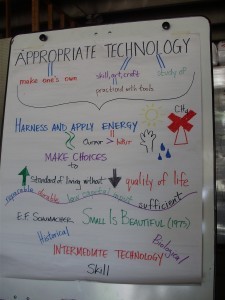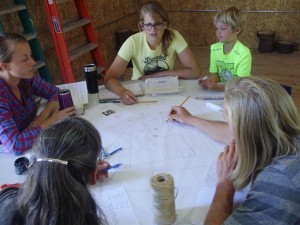 by Trudy Thomas
by Trudy Thomas
Casting stones at companies that devastate the environment to wrest fossil fuels from the earth may seem justified. Using billions of gallons of water to frack for oil and gas is loathsome, right? But those who grouse about it must contend with the fact that they themselves are not without sin. The way we heat and cool our homes, preserve food, cook meals, wash dishes, dry clothes and style our hair contributes to bloated, inefficient energy demands on our beleaguered planet.
Local architect Scott Harvey reminded students at the August permaculture design certification class that not all technologies are equal. Some are useful when appropriately applied while others offer convenience at a high energy cost. We can choose to use energy when we really need it, to conserve as much as possible or abandon technology that indiscriminately spends energy.
Related: See photos from the August class
According to a Consumer Reports wattage calculator, the top capacity household appliances, greatest to least, are central air conditioning, electric oven, electric clothes dryer, dishwasher, hair dryer, iron, toaster oven, vacuum cleaner, coffee maker, microwave and refrigerator. Online sources vary slightly in the order but generally speaking, these are the biggest energy consumers.
Harvey said appliances with a remote or clock (like a coffee maker) draw energy 24 hours a day. He recommended that remotely controlled appliances be plugged in to a power strip and the power strip turned off when the appliance is not in use.
 Criteria for determining appropriate technology include looking for solutions that are simple, efficient, have minimal side effects, cost effective, durable and use local resources and knowledge. Sometimes solutions are incredibly simple. In buildings, for example, efficiency may be significantly achieved by repurposing.
Criteria for determining appropriate technology include looking for solutions that are simple, efficient, have minimal side effects, cost effective, durable and use local resources and knowledge. Sometimes solutions are incredibly simple. In buildings, for example, efficiency may be significantly achieved by repurposing.
“The most sustainable building is the one that’s already been built,” Harvey said.
Part of the problem in finding simpler, more efficient and cleaner technology is that since the 1850s, the western world has run on a finite source of incredibly powerful energy. Our whole economic system depends on the availability and production of fossil fuel. Renewable energies like wind and solar cannot keep pace with its energy output.
Fossil fuel, though made from plant and animal materials compressed deep within the earth for millions of years, is not considered renewable because even though the process continues, we are using up supply faster than it can be produced. In the little more than 150 years since its commercialization, we have used up the readily available supplies of petroleum. Adding to this is the demand from China and India, so that as supplies dwindle, demand increases, further stressing the system. We must find other ways to power our economic system, ways that do not damage the earth and don’t take millions of years to renew supplies.
Along with this, is the lesson that mankind must not consume indiscriminately. We don’t need our clothes dryer when we can use the sun’s energy. We don’t need central air conditioning when we can build homes with natural materials that insulate well. In other words, our convenience and welfare should not be our primary goal. Our primary goal should be meeting our needs as we consider the needs of our ecosystem.
A decentralized approach to energy production can also increase efficiency. Harvey said that whenever energy is converted, it loses some efficiency. Collecting and using energy as close to the source as possible reduces the loss. A roof-top solar array, for example, uses energy at the source.
Energy efficiency is improved by using the right materials for the right situation. Harvey said the average home loses 41 percent of its heat through the windows. Twenty-four percent of heat is lost through the walls. Seventeen percent is lost through doors and 10 and 8 percent, respectively, are lost through the roof and floors. Straw bale walls, for example, provide a high level of insulation without toxic and fossil fuel components. In warmer climates, the thermal mass of cob will hold and release heat in order to stabilize indoor air temperature.
Harvey explained that even heaters are not all created equal. With the decline of fossil fuels, interest in wood burning has renewed. Unfortunately wood burning stoves are not energy efficient. Much of the heat is lost through the flue, as the gases and smoke are released too quickly. New technologies, such as the rocket or masonry stove, use small amounts of wood and delay the release of debris, thus allowing more heat radiation and less smoke entering the atmosphere.
When the social networks and news outlets are full of bad news about the state of our planet and of the corporations raping and pillaging the earth’s resources, think about what you can do to reduce or eliminate your part in their destructive dance. Throw out your hair dryer, buy a bike and ride to work or maybe sell your fossil fuel-produced home and build your own with natural materials and renewable energy.
The time is ripe for change, the need is now and the future is full of possibility.
“When we start making renewable energy from renewable systems,” said Harvey, “we are into the perfect paradigm.”






